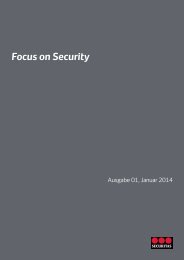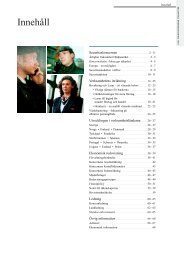SECURITAS AB Annual Report 2011
SECURITAS AB Annual Report 2011
SECURITAS AB Annual Report 2011
You also want an ePaper? Increase the reach of your titles
YUMPU automatically turns print PDFs into web optimized ePapers that Google loves.
82 <strong>Annual</strong> <strong>Report</strong><br />
Notes and comments to the consolidated financial statements<br />
including such items as accounts payable and other current liabilities and<br />
also any long-term and short-term loans not included in the category financial<br />
liabilities designated for hedging.<br />
Further information regarding carrying and fair values is provided in the<br />
table Financial instruments by category – carrying and fair values in note 6<br />
as well as in the definitions of the categories below.<br />
Financial assets or financial liabilities at fair value through profit or loss<br />
Financial assets at fair value through profit or loss have two sub-categories:<br />
financial assets held for trading, and those designated at fair value through<br />
profit or loss at inception. A financial asset is classified in this category if<br />
acquired principally for the purpose of selling in the short-term or if so<br />
designated by management. Fair value derivative assets are also categorized<br />
as held for trading unless they qualify for hedge accounting. Assets in<br />
this category are classified as current assets if they are either held for trading<br />
or are expected to be realized within 12 months of the balance sheet date.<br />
financial liabilities at fair value are trading securities with negative fair value;<br />
normally derivative liabilities unless they qualify for hedge accounting.<br />
Loans and receivables<br />
Loans and receivables are non-derivative financial assets with fixed or<br />
determinable payments that are not quoted in an active market. They arise<br />
when the Group provides money, goods or services directly to a debtor with<br />
no intention of trading the receivable. They are included in current assets,<br />
except for loans and receivables with maturities later than 12 months after<br />
the balance sheet date.<br />
Held-to-maturity investments<br />
Held-to-maturity investments are non-derivative financial assets with fixed<br />
or determinable payments and fixed maturities that the Group’s management<br />
has the positive intention and ability to hold to maturity.<br />
Available-for-sale financial assets<br />
Available-for-sale financial assets are non-derivatives that are either designated<br />
in this category or not classified in any of the other categories. They<br />
are included in non-current assets unless management intends to dispose<br />
of the investment within 12 months of the balance sheet date.<br />
Financial liabilities designated as hedged item in a fair value hedge<br />
This category includes financial liabilities designated as hedged item in a fair<br />
value hedge. The hedging instruments are included in the category derivatives<br />
designated for hedging. Financial liabilities designated as hedged item<br />
in a fair value hedge are included in non-current liabilities except for liabilities<br />
with maturities later than 12 months from the balance sheet date.<br />
Other financial liabilities<br />
Other financial liabilities are any financial liabilities that are not included in<br />
either of the categories financial liabilities designated as hedged item in a<br />
fair value hedge or financial liabilities at fair value through profit or loss.<br />
They are included in current liabilities except for liabilities with maturities<br />
later than 12 months from the balance sheet date.<br />
Securitas <strong>Annual</strong> <strong>Report</strong> <strong>2011</strong><br />
Derivatives designated for hedging<br />
The Group normally only enters into derivative contracts when they either<br />
qualify for hedge accounting or when there is a natural off-set in the<br />
accounting. This category includes the first type of derivatives. Derivatives<br />
where the hedged item or the item for which a natural off-set in the accounting<br />
is sought has a maturity within 12 months after the balance sheet date<br />
are either included in current assets on the line other interest-bearing current<br />
assets, or in current liabilities on the line other short-term loan liabilities.<br />
Derivatives where the hedged item or the item for which a natural off-set in<br />
the accounting is sought has a maturity later than 12 months after the balance<br />
sheet date are either included in non-current assets on the line other<br />
interest-bearing financial non-current assets, or in long-term liabilities on<br />
the line other long-term loan liabilities.<br />
Recognition and subsequent measurement<br />
Purchases and sales of financial instruments are recognized on the trade date<br />
– the date on which the Group commits to purchase or sell the instrument.<br />
Financial assets and liabilities are initially recognized at fair value plus<br />
transaction costs for all financial assets or financial liabilities not carried at<br />
fair value through profit or loss. Financial assets or liabilities at fair value<br />
through profit or loss are recognized at fair value. Any transaction costs are<br />
charged to the statement of income.<br />
Financial assets are derecognized when the rights to receive cash flows<br />
from the instruments have expired or have been transferred and the Group<br />
has transferred substantially all risks and rewards of ownership. Financial<br />
liabilities are removed when the obligation is discharged, cancelled or has<br />
expired.<br />
Financial assets or financial liabilities at fair value through profit or loss<br />
and available-for-sale financial assets are subsequently carried at fair value.<br />
Loans and receivables and held-to-maturity investments are carried at<br />
amortized cost using the effective interest method. Realized and unrealized<br />
gains and losses arising from changes in the fair value of the financial assets<br />
or liabilities at fair value through profit or loss category are included in financial<br />
income or financial expenses in the statement of income in the period<br />
in which they arise.<br />
Financial liabilities with the exception of financial liabilities at fair value<br />
through profit or loss and financial liabilities designated for hedging are<br />
subsequently carried at amortized cost.<br />
financial liabilities designated as the hedged item in a fair value hedge<br />
are carried at amortized cost but are adjusted for changes in the fair value<br />
due to the hedged risk. Changes in the fair value are included in financial<br />
income or financial expenses in the statement of income in the period in<br />
which they arise. The corresponding gain or loss from re-measuring the<br />
hedging instrument at fair value is also included in financial income or<br />
financial expenses in the statement of income in the same period as that<br />
in which the gain or loss on the hedged item arises.<br />
Cash flow hedging instruments are carried at fair value in the balance<br />
sheet and the gains or losses from re-measuring the hedging instruments<br />
at fair value are recognized in the hedging reserve in other comprehensive<br />
income with a reversal from the hedging reserve to the statement of income<br />
in the period of which the cash flow of the hedged item impacts the statement<br />
of income. Exchange rate gains and losses on derivatives that are part<br />
of a net investment hedge relationship are recognized in other comprehensive<br />
income. Any ineffectiveness is recognized in the statement of income.

















